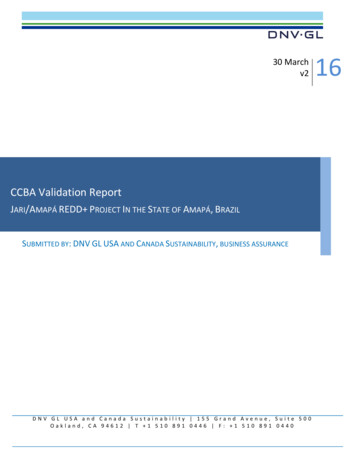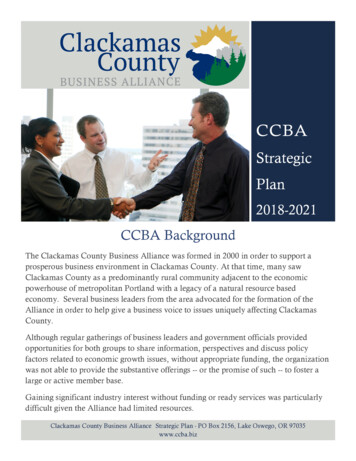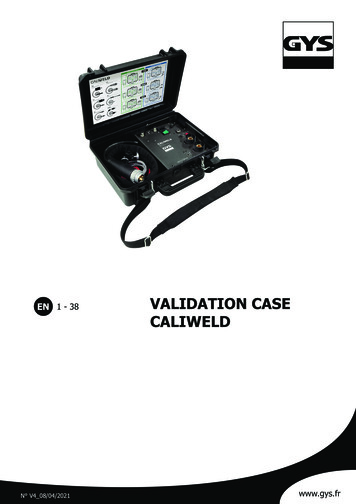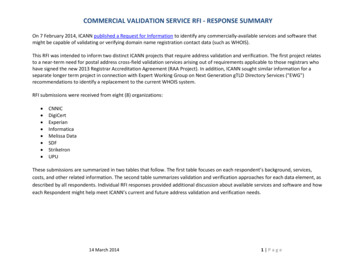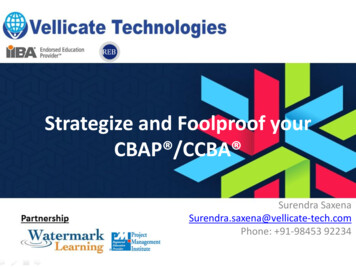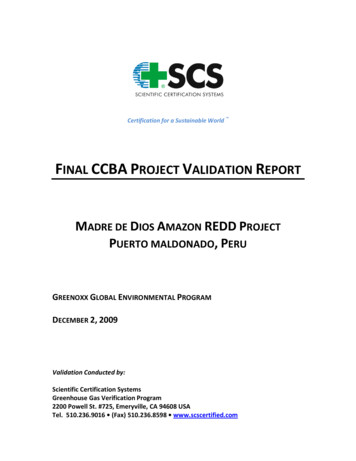
Transcription
Certification for a Sustainable World FINAL CCBA PROJECT VALIDATION REPORTMADRE DE DIOS AMAZON REDD PROJECTPUERTO MALDONADO, PERUGREENOXX GLOBAL ENVIRONMENTAL PROGRAMDECEMBER 2, 2009Validation Conducted by:Scientific Certification SystemsGreenhouse Gas Verification Program2200 Powell St. #725, Emeryville, CA 94608 USATel. 510.236.9016 (Fax) 510.236.8598 www.scscertified.com
MADRE DE DIOS AMAZON REDD PROJECTPUERTO MALDONADO, PERUClimate, Community and BiodiversityProject Design Standards, First Edition
Table of Contents1.0Introduction . 11.1. Contact Information. 11.2. Objective . 21.3. Scope and Criteria . 21.4. Project Description. 21.5. Summary of Validation Conclusion . 22.0Methodology . 32.1. Auditor Qualifications . 32.2. Audit Process . 43.0Stakeholder Comments. 54.0CCB Validation Findings . 54.1. General Section . 54.1.1. G1 – Original Conditions at Project Site . 54.1.2.G2 – Baseline Projections . 134.1.3.G3 – Project Design and Goals . 194.1.4.G4 – Management Capacity . 234.1.5.G5 – Land Tenure . 254.1.6.G6 – Legal Status . 274.1.7.G7 – Adaptive Management for Sustainability . 294.1.8.G8 – Knowledge Dissemination . 314.2. Climate Section . 334.2.1.CL1 – Net Positive Climate Impacts . 334.2.2.CL2 – Offsite Climate Impacts (“Leakage”) . 374.2.3.CL3 – Climate Impact Monitoring . 394.2.4.CL4 – Adapting to Climate Change & Climate Variability . 404.2.5.CL5 – Carbon Benefits Withheld from Regulatory Markets . 414.3. Community Section . 414.3.1.CM1 – Net Positive Community Impacts . 424.3.2.CM2 – Offsite Community Impacts . 464.3.3.CM3 – Community Impact Monitoring . 484.3.4.CM4 – Capacity Building . 494.3.5.CM5 – Best Practices in Community Involvement . 524.4. Biodiversity Section. 554.4.1.B1 – Net Positive Biodiversity Impacts . 554.4.2.B2 – Offsite Biodiversity Impacts. 594.4.3.B3 – Biodiversity Impact Monitoring . 614.4.4.B4 – Native Species Use . 624.4.5.B5 – Water & Soil Resource Enhancement . 644.5. Other Findings. 655.0CCB Validation Conclusion . 65Appendix ACCBA Compliance ChecklistAppendix BStakeholder CommentsAppendix DGroup Interview Protocol and TranscriptAppendix CSummary of Worker InterviewsAppendix EPhone Interview Protocol and Transcript
Table of FindingsNIR Number 3 of 8 Dated June 12, 2009 . 7NIR Number 4 of 11 Dated July 10, 2009 . 8NIR Number 4 of 8 Dated June 12, 2009 . 9NIR Number 1 of 11 Dated July 10, 2009 . 10NIR Number 2 of 11 Dated July 10, 2009 . 12NIR Number 5 of 8 Dated June 12, 2009 . 14NCR Number 2 of 5 Dated September 22, 2009 . 16OFI Number 1 of 3 Dated July 10, 2009 . 16OFI Number 2 of 3 Dated July 10, 2009 . 17NIR Number 3 of 11 Dated July 10, 2009 . 18NIR Number 5 of 11 Dated July 10, 2009 . 21NIR Number 7 of 8 Dated June 12, 2009 . 25NIR Number 6 of 11 Dated July 10, 2009 . 26NIR Number 2 of 8 Dated June 12, 2009 . 29NIR Number 6 of 8 Dated June 12, 2009 . 34NIR Number 7 of 11 Dated July 10, 2009 . 34NCR Number 1 of 5 Dated September 22, 2009 . 35NIR Number 8 of 11 Dated July 10, 2009 . 38NIR Number 9 of 11 Dated July 10, 2009 . 40NCR Number 3 of 5 Dated September 22, 2009 . 43NIR Number 8 of 8 Dated June 12, 2009 . 45NIR Number 10 of 11 Dated July 10, 2009 . 47NIR Number 1 of 8 Dated June 12, 2009 . 53NCR Number 4 of 5 Dated September 22, 2009 . 57NIR Number 11 of 11 Dated July 10, 2009 . 60OFI Number 3 of 3 Dated July 10, 2009 . 62NCR Number 5 of 5 Dated September 22, 2009 . 65
CCBA Project Final Validation ReportMadre de Dios Amazon REDD ProjectPage 11.0 IntroductionThis report presents the findings of an audit conducted by Scientific Certification Systems (SCS),to validate the claim made by Greenoxx Global Environmental Program that the Madre de DiosAmazon REDD Project conforms to the Climate, Community and Biodiversity Project DesignStandards (First Edition). SCS has been accredited by the Climate, Community & BiodiversityAlliance (CCBA) to perform such validation audits.1.1. Contact InformationGreenoxx contact:Rocco Cheirasco, Chairman & CEOSilvia Gomez Caviglia, Executive Vice PresidentAlejandro Schroeder 6478, of 401CP 11500, Montevideo UruguayTel. mScientific Certification Systems contact:Todd Frank, Program Manager, GHG Verification ServicesScientific Certification Systems2200 Powell Street, No. 725Emeryville, CA 94608 USATel. 510.236.9016tfrank@scscertified.comKyle Holland, Verification Forester, GHG Verification ServicesScientific Certification Systems2200 Powell Street, No. 725Emeryville, CA 94608 USATel. 510.236.9015tfrank@scscertified.comSandra VelardeSCS Contract VerifierTel. 51.1.444.8830sjvelarde@gmail.comScientific Certification SystemsDecember 2009
CCBA Project Final Validation ReportMadre de Dios Amazon REDD ProjectPage 21.2. ObjectiveThe validation objective is an independent assessment by SCS of the proposed project activityagainst all defined criteria as defined by the Climate, Community and Biodiversity Alliance(CCBA). Validation results in a conclusion by SCS whether the project activity is compliant withthe CCB standards and whether the project should be submitted for registration with CCBA. Theultimate decision on the registration of a proposed project activity rests with CCBA.1.3. Scope and CriteriaThe project was assessed against the CCB Standards First Edition to determine which of thefourteen required and three optional CCB Standards criteria the project satisfies. An “Approved”project is one which satisfies all 15 of the required CCB Standards criteria.1.4. Project DescriptionThe Madre de Dios Amazon REDD Project (“the Project”) is a Reduced Emissions fromDeforestation and Forest Degradation (REDD) project. The Project is designed around theimpending effects of a new trans-Amazonian, inter-oceanic road that is nearly complete fromBrazil to the Pacific Ocean and Peruvian ports. The remaining stretch of the new road isscheduled for completion in 2009 and the completed road system will facilitate the immigrationof new settlers into the region. The immigrant population is predicted to subsist by agriculturaland agricultural livestock activities. Deforestation and forest degradation are a result of theseactivities. These effects are already visible in Brazil where the trans-Amazonian road has beencomplete for some time.The project zone is located near the village of Inapari, Peru, and project activities will beimplemented to protect the forest within the project zone from deforestation and degradation.The project area is two forest concessions which are administered by private companies andgranted by the Peruvian government. The two forest concessions, Maderacre and Maderyja,have the exclusive rights to the environmental services within the project area, including forestcarbon. However, the projected cost of protecting the forests from impending immigration willstrain the financial resources of Maderacre and Maderyja; project activates such as surveillance,community technical assistance and education are too expensive without a supplementalrevenue source.Project activates will be subsidized by the sale of carbon offset credits and will likely havemeasureable climate, community and biodiversity benefits. The “without-project” scenario isdeforestation and degradation while the “with-project” scenario is sustainable forestmanagement. As demonstrated by project proponents, avoided deforestation and degradationclearly have positive climate and biodiversity impacts. Moreover, project activities are speciallydesigned to achieve positive community impacts in addition to avoiding deforestation anddegradation.1.5. Summary of Validation ConclusionFollowing completion of SCS’s duly-accredited validation process, it was our conclusion that theMadre de Dios Amazon REDD Project conforms to the CCBA Climate, Community andScientific Certification SystemsDecember 2009
CCBA Project Final Validation ReportMadre de Dios Amazon REDD ProjectPage 3Biodiversity Project Design Standards (First Edition) at the Gold Level (see Appendix A), subjectto 5 Non-conformity Reports (NCRs) 3 Opportunities for Improvement (OFIs) and 19 NewInformation Requests (NIRs). The project proponents provided satisfactory responses to theNCRs issued as a result of the initial evaluation and it is our opinion that the project now fullymeets the standards at the Gold Level.2.0 MethodologySCS began reviewing the Project in June of 2009, beginning with a desk audit of Projectdocumentation, phone calls and email correspondence with Greenoxx. Two auditors, oneinternal to SCS and one independent of SCS, conducted a formal site visit and validationassessment from June 23rd to June 27th, 2009. Additional stakeholder interviews and a furtherreview of documentation, audit findings, and public comments submitted to the CCBA wereperformed by the auditors after the site visit and before a draft report was issued in Decemberof 2009. Several findings were issued prior to the draft report: 5 Non-conformity Reports, 3Opportunities for Improvement and 19 New Information Requests. Prior to the final report andwithin a certain time period, the project proponents responded to these findings.SCS conducted its evaluation to validate claims that the Project conforms to the CCBA Climate,Community and Biodiversity Project Design Standards (First Edition) (“the CCB Standards”). TheCCB Standards require conformance to 15 criteria in each of 4 sections: 1) General (6 criteria),2) Climate (3 criteria), 3) Community (3 criteria), and 4) Biodiversity (3 criteria). In addition,applicants can achieve a higher level of validation through the application of up to eightvoluntary criteria in these sections. Gold level validation can be achieved by projects that meetthe core requirements and at least six optional Gold Level criterion, one from each section.2.1. Auditor QualificationsLead Verifier: Kyle Holland, SCS Verification ForesterKyle Holland is a Certified Forester with an extensive background in forest management,modeling and assessment. Prior to joining SCS in 2009, Kyle managed thousands of acres offorestland as a Resource Supervisor with the Potlatch Corporation. In this position, Kyle wasresponsible for the day-to-day practicalities of forest administration, silviculture and fiberprocurement. In the public sector, Kyle has served the Chesapeake Bay Program, the State ofMaryland and the State of Wisconsin as a forestry specialist, working on riparian forestry issuesand forest management auditing. Kyle is currently completing his PhD in forest biometrics andstatistics at the University of California, Berkeley, and has forestry degrees from Berkeley, theUniversity of Minnesota and the University of Idaho. His dissertation topic is the estimation andmodeling of biomass from remotely-sensed data. Kyle holds numerous certifications from theSociety of American Foresters, the American Tree Farm System, State of Minnesota, State ofWisconsin and the State of California. He also holds professional memberships with the Societyof American Foresters, the American Society for Photogrammetry and Remote Sensing, theInstitute of Mathematical Statistics and the International Environmetrics Society. Kyle hasconducted numerous verification and validation activities under FSC, CCX, CAR, CCB and VCS.Scientific Certification SystemsDecember 2009
CCBA Project Final Validation ReportMadre de Dios Amazon REDD ProjectPage 4Verifier: Sandra Velarde, SCS Contract VerifierSandra J. Velarde is a Peruvian Forest Engineer with seven years of international research andcommunications experience in the fields of participatory planning, natural resource economicsand integrated land use assessment (biodiversity, carbon sequestration, land use profitability,participatory scenarios and negotiation support systems) in the humid tropics. Sandra is adirector of MASALI, a Peruvian company that specializes in environmental management and civilengineering. She frequently consults for the World Agroforestry Center and The World BankCarbon Finance Unit on reducing emissions from avoided deforestation and degradation (REDD).In 2009, Sandra co-led the development of the Peruvian climate change research agenda, withthe National Council for Science and Technology and the Ministry of Environment. Sandra alsohas professional relationships with ASB, the Amazon Initiative, hosted by the World AgroforestryCenter in Nairobi, Kenya, and Centro Internacional de Agricultura Tropical (CIAT) in Belém,Brasil. She has extensive field experience in Peru, Brasil, Thailand and Indonesia related toforestry issues. Sandra has also analyzed socio-economic trends in forestry for Latin Americathough her relationship with FAO, Rome. Sandra holds a MSc. in Ecological Economics from theUniversity of Edinburgh, Scotland, forestry degrees and a special diploma in AgribusinessManagement from Universidad Nacional Agraria La Molina, Peru.2.2. Audit ProcessThe audit process included the following steps:Reviewed the Project Design Document (PDD) for completeness.Submittal to CCBA for public comment.Initial review of the PDD and supporting materials, including:o A supplementary profile on Maderacre and Maderyja titled AvoidedDeforestation Project; ando A research working paper titled Roads, Lands, Markets and Deforestation byChomitz and Gray, The World Bank.Issuance of initial NIRs to project proponents for more information.Site visit June 23rd though the 27th, 2009, that included:o Initial client meeting and project orientation;o Project overview by AIDER, Maderacre and Maderyja (various PowerPointpresentations);o Discussions about the project criteria and indicators;o Meetings project stakeholders, including local community groups andgovernment representatives;o Field trips to deforestation areas, Brazil, project zone, project area and localcommunities; ando Closing meeting to discuss findings.Follow up and phone interviews with stakeholders.Review of stakeholder comments from CCBA.Issuance of NIRs, OFIs and NCRs to project proponents.Response to NIRs, OFIs and NCRs by project proponents.Further document review and draft validation report preparation.Technical review and approval of the draft report by SCS staff.Preparation of CCBA Statement of Compliance.Scientific Certification SystemsDecember 2009
CCBA Project Final Validation ReportMadre de Dios Amazon REDD ProjectPage 53.0 Stakeholder CommentsThe Project Design Document (PDD) was posted on the CCBA website on June 7th and the publiccomment period extended through June 30th, 2009. Comments were received from one party(see Appendix B).Written comment(s) were received from:Alfredo Rodríguez Zunino, WWF Peru Programme OfficeAll comments have been addressed by the auditor in this report.4.0 CCB Validation FindingsThis report of our validation findings addresses each of the CCBA criteria and indicators. Foreach criterion, the CCBA indicators are listed along with a description of the evidence that wasconsidered, the findings from the audit and when applicable, Non-Conformity Reports (NCRs),Opportunities for Improvement (OFIs) and New Information Requests (NIRs). In the case of nonconformance, a Non-Conformity Report stipulates the deficiency and its relation to the CCBprotocol. NCRs indicate broad non-conformance at the criterion level that must be satisfiedprior to project validation. An Opportunity for Improvement is issued when overallconformance with a criterion has been achieved but in instances where actions could be takento further ensure compliance with an indicator. A New Information Request indicates whenadditional information is necessary to complete the validation. Responses to all NIRs and NCRsmust be received prior to project validation.Throughout the remainder of the report, Greenoxx, AIDER NGO, Maderacre and Maderyja arereferred to as the “Project Proponents” or “the Proponents”. The Project Proponents collatedmuch of their Project information in a document entitled Madre de Dios Amazon REDD Projectdated June 4th, 2009 which is available to the public on the CCBA website (http://www.climatestandards.org). The CCBA refers to such documents as Project Design Documents (PDD). ThePDD was revised on October 31, 2009 in response to findings issued in the draft report as part ofthe evaluation process (see NCR 5 of 5 for September 22, 2009).4.1. General SectionThe General Section of the CCB Standards addresses project site conditions, baselineprojections, project design and goals, management capacity, land tenure, legal status, adaptivemanagement, and knowledge dissemination.4.1.1. G1 – Original Conditions at Project SiteThe original conditions at the project site before the project commences must be described.This description, along with projections (see G2), will help determine the likely impacts of theproject.Scientific Certification SystemsDecember 2009
CCBA Project Final Validation ReportMadre de Dios Amazon REDD ProjectPage 6Indicator G1.1. The location of the project and basic physical parameters (e.g., soil, geology,climate).Findings: The Project Design Document (PDD) describes the location of the project and thebasic physical parameters. The Project is located in the hydrographic basin of the Acre River,Iñapari district, Tahuamanu province in the Madre de Dios department in the Peruvian Amazon.The Madre de Dios Valley is characterized by a soft and undulated topography, where thealluvial plain dominates (complex of borders and terraces) and low hills. In the high hill sector,classified as High Hills from the Quaternary, the rivers De las Piedras, De los Amigos andTahuamanu originate.Generally, soils are poor in nutrients due to the nature of the lithology below, the strongchemical meteorization (caused by high temperatures and high humidity) and the washing ofnutrients due to heavy rain during a great part of the year. In these natural conditions, thefertility of the soil is linked to the organic cycle.The regional climate is variable. The average medium annual temperature varies between 22ºCand 26ºC, with very low variation during the year, obtaining the highest average monthlyregistries during the months comprehended between September and April, while the lowestaverage monthly registries occur between May and August. The area is characterized by thepresence of abundant rainfall during most part of the year, being able to differentiate a longseason denominated “winter” from October to May and a short dry season denominated“summer” from June to August.Conformance:YesNoNon-Conformity Reports:NoneNew Information Requests:NoneOpportunities for Improvement:NoneN/AIndicator G1.2. The types and condition of vegetation at the project site.Findings: The PDD describes the types and condition of vegetation at the project site. TheProject Proponents classify the project site into three types: low terrace forest, low hill foresthighly dissected and low hill forest highly dissected with “paca”. Descriptions and conditions ofeach of these types are available in the PDD in Section A.2. Indidual tree species are discussed inSection C.2.Conformance:YesNoNon-Conformity Reports:NoneNew Information Requests:NoneOpportunities for Improvement:NoneScientific Certification SystemsDecember 2009N/A
CCBA Project Final Validation ReportMadre de Dios Amazon REDD ProjectPage 7Indicator G1.3. Current carbon stocks at the project site(s), using methodologies from theIntergovernmental Panel on Climate Change’s Good Practice Guidance (IPCC GPG) or otherinternationally-approved methodologies (e.g., from the CDM Executive Board).Findings: The current carbon stocks at the project site are estimated using a Tier 3 methodologyfrom the IPCC GPG. The project area was first stratified by forest type using satellite imageryand within each forest type, permanent plots were installed. These plots are measuredregularly to estimate carbon stocks using above and below ground biomass equations for treespecies within the project area. Current carbon stock estimates and the specific methodologyare reported in section D.4.1.Initially, the methodology for estimating current carbon stocks and the referenced biomassequations were unclear (see NIR 3 of 8 for June 12 and NIR 4 of 11 for June 10, 2009). Thisinformation was subsequently supplied in separate documents and ultimately added to therevised PDD (see NCR 5 of 5 for September 22, 2009).Conformance:YesNon-Conformity Reports:NoN/ANoneNew Information Requests:NIR Number 3 of 8 Dated June 12, 2009Finding: The Project Design Document (PDD) refers to a document called “Estimation of CarbonStocked in the Biomass of the Forestry Concessions of Maderacre and Maderyja, Madre de Dios,Peru” by AIDER NGO dated May 2009, in Section D.4.1. This document must be provided tovalidate, in part, the above referenced indicators.Proponent Response on September 15, 2009:Provided document: Estimation of Carbon Stocked in the Biomass of the Forestry Concessions of Maderacreand Maderyja, Madre de Dios, Peru” (in Spanish “Línea de Base de Carbono de Maderyja yMaderacre”), by AIDER NGO, dated May 2009.How it satisfies the NIR: It contains the estimation of the carbon stocked within the Maderacreand Maderyja concessions forests, applying approved methodologies.Validator Response: The document was provided and clarified the estimation methodology.Scientific Certification SystemsDecember 2009
CCBA Project Final Validation ReportMadre de Dios Amazon REDD ProjectPage 8NIR Number 4 of 11 Dated July 10, 2009Finding: A site visit to the project area was conducted as part of the audit from June 24ththough June 27th, 2009.Indicators G1.3 and G2.2: Several models were presented in the Project Design Document (PDD)and discussed during the site visit. Please provide documentation for the following models:a.GEOMOD deforestation model (Clark University) andb.Winrock biomass models (palms and Cecropias).Please ensure that the provided documentation addresses how these models were created andunder what assumptions.Proponent Response on September 15, 2009:Provided documents: 2003” “Spatial Modeling Of Baselines Carbon Projects – The GEOMOD Modeling Approach“Dynamic Models”“Pontius chen 2006 idrisi”“Winrock – BioCarbon Fund Sourcebook compressed”“Carbon Storage in The Los Amigos Conservation Concession”DINAMICAHow they satisfy the NIR: The aforementioned documents include information on the modelsthat were presented in the Project Design Document (PDD): GEOMOD deforestation model(Clark University) and Winrock biomass models (palms and Cecropias).Since the DINAMICA model was finally employed for the deforestation model, itsdocumentation was also provided.Validator Response: The provided references for biomass equations were adequate. Thebiomass models were parameterized outside the project area which violates an assumption ofgeographic applicability. However no alternative models are available and therefore thesemodels are the best available to the project.Part way through the validation, the GEOMOD model was abandoned for DINAMICA, a morerobust and geographically applicable model of deforestation. This model appears to be anadequate and reasonable substitution to predict spatial deforestation.Opportunities for Improvement:Scientific Certification SystemsDecember 2009None
CCBA Project Final Validation ReportMadre de Dios Amazon REDD ProjectPage 9Indicator G1.4. A description of communities located in and around the project area, includingbasic socio-economic information (using appropriate methodologies such as the livelihoodsframework).Findings: Information about the communities surrounding the project area– primarily, Inapariand Iberia – are included in PDD, Section F.1. Also, information about the Belgium NativeCommunity located in the project zone is given in Section F.3. The descriptions provided in thePDD include pertinent socio-economic information based on a livelihoods framework. Thedescription includes demographic, familial, education, health, occupation and economicinformation for the communities located in and around the project area.Originally, socioeconomic information was missing from the PDD and the referenced“Community Plan” (see NIR 4 of 8 for June 12 and NIR 1 of 11 for July 10, 2009). However it hassince been added to the revised PDD (see NCR 5 of 5 for September 22, 2009).Conformance:YesNon-Conformity Reports:NoN/ANoneNew Information Requests:NIR Number 4 of 8 Dated June 12, 2009
CCBA Project Final Validation Report Page 2 Madre de Dios Amazon REDD Project Scientific Certification Systems December 2009 1.2. Objective The validation objective is an independent assessment by SCS of the proposed project activity against all defined criteria as defined by the Climate, Community and Biodiversity Alliance (CCBA).
